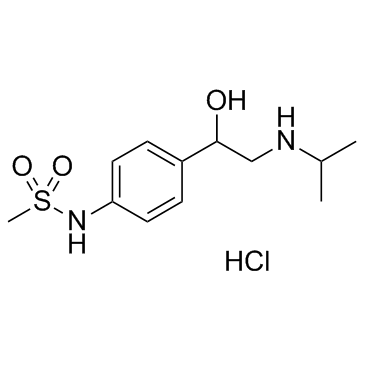Sotalol hydrochloride

Sotalol hydrochloride structure
|
Common Name | Sotalol hydrochloride | ||
|---|---|---|---|---|
| CAS Number | 959-24-0 | Molecular Weight | 308.825 | |
| Density | N/A | Boiling Point | 443.3ºC at 760 mmHg | |
| Molecular Formula | C12H21ClN2O3S | Melting Point | 218-220°C | |
| MSDS | Chinese USA | Flash Point | 221.9ºC | |
| Symbol |

GHS07 |
Signal Word | Warning | |
|
A pharmacologically validated, high-capacity, functional thallium flux assay for the human Ether-à-go-go related gene potassium channel.
Assay Drug Dev. Technol. 8 , 714-26, (2010) The voltage-gated potassium channel, human Ether-à-go-go related gene (hERG), represents the molecular component of IKr, one of the potassium currents involved in cardiac action potential repolarization. Inhibition of IKr increases the duration of the ventric... |
|
|
Resting heart rate and physical activity as risk factors for lone atrial fibrillation: a prospective study of 309,540 men and women.
Heart 99(23) , 1755-60, (2013) To study the impact of resting heart rate and leisure time physical activity at middle age on long term risk of drug treated lone atrial fibrillation (AF).Longitudinal cohort study of 309 540 Norwegian men and women aged 40-45 years examined during 1985-1999 ... |
|
|
Antiarrhythmic drug use in patients <65 years with atrial fibrillation and without structural heart disease.
Am. J. Cardiol. 115(3) , 316-22, (2015) Little is known in clinical practice about antiarrhythmic drug (AAD) use in patients with atrial fibrillation (AF) (particularly younger ones) who do not have structural heart disease. Using the MarketScan database, we identified patients <65 years without kn... |
|
|
In vitro model for assessing arrhythmogenic properties of drugs based on high-resolution impedance measurements.
Cell Physiol. Biochem. 29(5-6) , 819-32, (2012) Cardiac dysfunction is one of the main cause of drug candidate failures in the preclinical and/or clinical studies and responsible for the retraction of large number of drugs from the market. The prediction of arrhythmic risk based on preclinical trials durin... |
|
|
Characterization of A-935142, a hERG enhancer, in the presence and absence of standard hERG blockers.
Life Sci. 90(15-16) , 607-11, (2012) In a previous study we found that A-935142 enhanced hERG current in a concentration-dependent manner by facilitating activation, reducing inactivation, and slowing deactivation (Su et al., 2009). A-935142 also shortened action potential duration (APD90) in ca... |
|
|
Life-threatening hyperkalemia: a potentially lethal drug combination.
Conn. Med. 77(8) , 491-3, (2013) Hyperkalemia is commonly seen in the elderly and is occasionally fatal. Inadvertently combining potassium sparing medications can result in profound hyperkalemia which may result in cardiac dysrhythmias, especially in the setting of chronic kidney disease. An... |
|
|
Episodic syncope caused by ventricular flutter in a tiger (Panthera tigris).
J. Zoo Wildl. Med. 44(2) , 500-4, (2013) A captive, 9-yr-old castrated male tiger (Panthera tigris) from an exotic cat sanctuary and rescue facility was observed to have three collapsing episodes within a 2-wk interval prior to being examined by veterinarians. No improvement in clinical signs was no... |
|
|
The effect of Rho-associated kinase inhibition on the ocular penetration of timolol maleate.
Invest. Ophthalmol. Vis. Sci. 54(2) , 1118-26, (2013) To assess the effects of Rho-associated kinase (ROCK) inhibition on the intraocular penetration of timolol maleate.Ex vivo porcine corneal penetration of timolol maleate, sotalol hydrochloride, or brinzolamide incubated with or without Y-27632 was determined ... |
|
|
Intraosseous infusion is unreliable for adenosine delivery in the treatment of supraventricular tachycardia.
Pediatr. Emerg. Care 28(1) , 47-8, (2012) Supraventricular tachycardia (SVT) is a common tachyarrhythmia in the pediatric population that can necessitate immediate treatment. Adenosine has been well studied as a mainstay treatment, but the methods of adenosine administration have not been very well d... |
|
|
[Atrial fibrillation after coronary artery bypass surgery: possibilities of prevention].
Srp. Arh. Celok. Lek. 140(7-8) , 521-7, (2012) Atrial fibrillation occurs as a frequent complication after cardiac interventions. It can be found in 5% of all surgical patients, and it is far more common in cardiac (10% - 65% of patients) than in non-cardiac procedures. In a number of patients it remains ... |